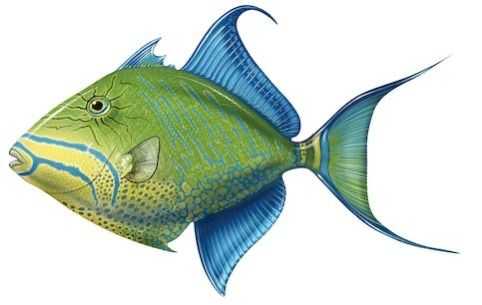Queen Triggerfish

Species Details
Balistes Vetula
Balistidae
Tetraodontiformes
Onshore, Offshore, Reef, Wreck
6 - 12 lbs.
11" - 24"
Queen Triggerfish (Balistes Vetula) Fish Description
The Queen Triggerfish is an oval and colorful fish. They have neon blue curved stripes that branch from their upper lip and end near their pectoral fin. Their fins are also slate blue with neon blue linings at the edges. They are predominantly dark yellow with a light bright yellow patch near their eye. Their throats appear to be a dirty yellow color.
However, Queen Triggerfishes can also come in different colors such as turquoise, purple, and green. But these fish are capable of changing color. They do so in a form of camouflage or when they are subjected to stress. They have two dorsal fins. One is composed of 1-2 large spines and 1 short spine. The other one starts with one large spine with several rays that run parallel to their anal fin which both fins look somewhat connected to their caudal fin. Their tail fin looks falcate in appearance. Whereas their anal fin appears to have a square edge.
Queen Triggerfish Diet
Queen Triggerfishes prefer eating benthic invertebrates. However, their most preferred food is sea urchins. They are known to flip sea urchins where the spines are short to eat them. They also feed on shrimps, bivalves such as clams, starfishes, macroalgae, and crabs. They usually feed during the morning.
Queen Triggerfish Size
Queen Triggerfishes can grow up to 23.6 inches. However, on average, the Queen Triggerfish only grows up to 11.8~12 inches. Upon reaching 11-12 inches, Queen Triggerfishes are known to reach sexual maturity. Their maximum weight is known to be 12 lbs.
Interesting Facts about the Queen Triggerfish
- Queen Triggerfishes are actually shy creatures except during mating season.
- During spawn season, the Quen Triggerfish is known to leave nasty bites on whoever tries to catch it.
- Queen Triggerfishes can produce throbbing sounds to warn other fish away.
- When being dragged out, the Queen Triggerfish will wedge itself in a crevice by using its dorsal fins. This is where it gets its name.
- Queen Triggerfishes are used for a variety of medical purposes.
- Parts of the fish are traditional treatments for earaches, asthma, and those who suffered from a stroke.
- Aesthetically, it’s a beautiful fish. Unfortunately, it doesn’t like staying with other fish.
- Usually, people catch the Queen Triggerfish as a trophy or pet fish.
- Its aggressive nature makes it hard for people to mix the Queen Triggerfish with other fishes especially when they get bigger.
Queen Triggerfish – Fishing Techniques: How to Fish for a Queen Triggerfish
When catching a Queen Triggerfish, find where they are. The most common places they like staying in are reefs, bottoms, and ledges. There are times however they can be found in an occasional shipwreck if there are not enough ledges in the area where they can hide. Queen Triggerfishes also like lurking near soft coral.
They usually stay among 5-10 fish. Other than that, the Queen Triggerfish is quite solitary as a fish. As a mesopelagic fish (meaning they’re somewhat near the surface but not near the bottom), Queen Triggerfishes can stay in waters that are 9.8 to 98.4 ft deep. They can also go as deep as 902 ft. Someone managed to catch a Queen Triggerfish at 90-150 ft.
As for the type of rig to catch them, some people recommend the Carolina Rig because of how easy it is to set up. All it needs is a sliding sinker, a plastic bead, a swivel, a bit of a leader, and a hook. Others recommend a dropper rig as it’ll help you fish into the deeper parts of the ocean.
For bait, Queen Triggerfish will love shrimp and some small crabs.
Queen Triggerfish Habitat and Distribution
Queen Triggerfish stays in the Western Atlantic, from Canada to Brazil. They were also seen in the Eastern Atlantic at Ascension, Cape Verde, Azores, and south heading to Angola. However, they do have some habitats in Florida, the Bahamas, and the Caribbean.
When fishing, look for rocky bottoms and places with a lot of reefs. That’s usually where the Queen Triggerfish will stay. That’s usually if they’re in a school. However, they can be found swimming around solo around sandy or grassy habitats in the deeper parts of the water.







